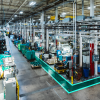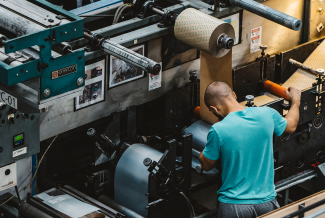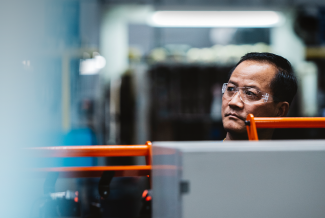

Now Available!
Get your copy of the 7th Annual State of Smart Manufacturing and hear from 300+ manufacturers in this new survey report!

Please complete the form to view
Trapped with old manufacturing software and no clear path forward?
Learn how your manufacturing business can adapt to rapid change, innovate quickly and refuse to be confined by old software models.
Download 5 ERP and MES Upgrade Challenges and How to Eliminate Them to:
- Understand why running legacy software is a dead-end solution.
- Uncover how traditional manufacturing software solutions create a money pit for manufacturers.
- Discover how SaaS-based cloud solutions developed specifically for manufacturers provides a better path to success.
At A Glance

Smart manufacturers adapt to rapid change and refuse to be confined by old software models.They are heavy mobile users, they innovate quickly and regularly, and they demand ERP software that supports their needs.
More Than Half of ERP and MES Customers Tend to Be Two Versions or More Behind
As a manufacturer, you focus on things like quality, equipment maintenance, profit, on-time delivery, and customer satisfaction. The last thing you want to think about is the age of your ERP and MES software.
Yet there you are, missing out on new features and innovations that could help your operations and your customers. But you’re not taking advantage of them. Why? Because you’re stuck in a world where your company constantly fights the battle of either falling behind or taking on those painful, disruptive, and costly software upgrades.
If you work in IT, this is just one of many software challenges you face, but it’s a big one. If you work in operations, you wince knowing that there is newer software available that works more efficiently and drives higher productivity. But the path to get there is not easy. Your software vendor presents an upgrade ‘strategy’ to you, but it involves a lot of time, disrupts your production and result in high implementation costs that were not scoped out at the time of the purchase.
Oftentimes companies don’t think about the pitfalls of their recently purchased or legacy ERP and MES systems. They are however, more than a nuisance. Data suggests that more than half of ERP and MES customers tend to be two versions or more behind. This has an impact on operations, revenue and your future as a manufacturer.
In this paper we will outline the top five ERP and MES upgrade challenges and how you can avoid them and ensure a successful future.
1. The Money Pit Legacy
ERP and MES software vendors make their money from lucrative annual maintenance contracts. Their profit mostly comes from charging roughly 18–40% of your total software license values annually to address bugs, provide customer support and access rights to new software versions. These costs don’t include upgrades to new versions or hiring support to implement them.
So you face a dilemma. Continue to pay for support on dead-end software versions, which won’t include significant new feature development, or pay even more to upgrade to a newer version. What a choice!
How about just installing those new features on your existing software version? Well, in most cases you can’t. Software vendors don’t add new features to old versions. You’re stuck either with an inability to leverage new features or having to incur extremely high customization costs to make those new features work with old versions. Neither is a great option.
2. Painful Upgrade Planning
If you decide to take a proactive approach and upgrade, this is not an easy undertaking. Because ERP and MES systems are so intertwined throughout your operation, upgrades have to be painstakingly planned to minimize disruption. You can’t just flip a switch.
Planning requires skin in the game from key stakeholders who should be focusing on driving business results, but instead are distracted by planning upgrades. It involves contingency plans and money to repair some of the inevitable broken customizations resulting from the upgrade. And finally it will probably involve peoples’ nights and weekends when the upgrade takes place so that impacts are minimized as much as possible to off-peak production time. If you run 24x7, then you just have to hope for the best.
Most ERP software vendors come out with quarterly, semi-annual, or annual software versions. That means you constantly have to invest valuable cycles and money in planning the frequency in which you will upgrade. You also have to weigh the true business benefits of every roadmap feature and software package to justify the business case for your upgrade.
This might sound familiar. An ERP or MES vendor has promised several marquis features for which you’ve been patiently waiting in its next release, only it slips one or two of those features to a later release. Now what? Do you upgrade again when the next version comes out or live without the new functionality until you adopt a formal release? Of course this is assuming the vendor actually deploys those features in the following version. In either case, you lose. Meanwhile, the vendor happily reaps the revenue of that maintenance support you pay for.
3. The Deal You Can’t Refuse
Maybe you think the version you currently have is good enough and you fall behind because you are content with it right now. This can work for some time and you get an occasional bug fixed here and there because of the support you pay for. What happens when the software vendor decides they will stop supporting your version or sunsets it? Now what?
Your company faces becoming isolated on an old version with no future support for it from the vendor.
Another scenario involves industry regulations. If a new regulation or compliance mandate comes up, ERP and MES vendors need to comply. This means that if you want to be in compliance, upgrading to a new version is a decision that needs to be made. Now you are forced into a new version whether you want it or not.
Often times the ERP or MES vendor is willing to offer you choices. You can continue with your current unsupported version, and come up with a solution if something goes wrong. The other choice that will be presented to you is to upgrade to the latest version, with some minor incentives in the form of discounts or waived fees — as long as you sign a new long-term contract. This upgrade will most likely require a full reimplementation that will probably cost as much or more as your original one. Does it feel like you are starting over with this option? That’s because you are.
Neither of these options seem appealing, but without other viable options, you opt for the upgrade which puts you right back on the road you came from, and facing the same decisions later on.
4. Questioning Your Decision
If you’ve ever bought a new car, you know the sinking feeling you have shortly after the excitement wears off. Researching new cars might have been exhilarating, test driving was fun, negotiating price was neither here nor there, but you get the keys and drive off the lot and are feeling content. Then you see the newest model, all shiny and gorgeous months after your purchase. It has a bunch of new standard features your model doesn’t have, and you realize you are missing out. Trade in the vehicle you purchased for the newer model, but that means dealing with a higher cost since your current vehicle has now depreciated.
Another option is to update your car to the latest capabilities, if that is even possible. The last is to keep your existing model, stew over not having the newest options, and plan another purchase somewhere down the road.
The same story applies to manufacturers who want the latest and greatest functionality but have to chase the constant version updates. You are never able to catch up, because new versions are constantly deployed. You’re running in quicksand, working hard but not really getting anywhere.
5. Alone in the Wilderness
Being ‘unique’ sometimes has great advantages, but feeling isolated is an entirely different story. In the case of ERP and MES software, if your company is running on a unique version or highly customized environment, software vendors are challenged to provide adequate support. Bugs are hard to validate, troubleshooting involves sifting through various bolt-ons and post-implementation additions and often results in multiple vendor finger-pointing in trying to boil down the root cause of the issue.
Maybe less obvious but no less important is the lack of version commonality among peer groups running a certain vendor’s software. Why is this important? If a vendor has many customers, those customers represent a potentially powerful peer group from which your company can learn best practices and with which your company can share learnings. If that peer community is using different software versions, however, best practices and shared helpful processes may not be relevant from one company to the other.
You have heard these discussions in user group meetings — “Wow, that’s great, what version are you on?” And from there the benefit unravels as users try to figure out if their version will support such a process.
The overall picture is one of a strong customer user group which, if leveraged properly, could help one another greatly by sharing ways in which they used ERP and MES software to improve their business. But with a bunch of versions of the vendor’s software installed across these companies, each effectively becomes isolated from one another. The result is a broken customer community.
Opportunity is Knocking
Meanwhile, the industry is changing every day. New competition and players are popping up, disruptive technologies are being introduced, new geographies are opening up in the global supply chain, and mergers and acquisitions are on the rise. Your company is missing out on the ability to adapt to rapid industry innovations, enabling it to further differentiate, but you can actually capitalize during this time.
Smart manufacturing technology is disruptive, real, and offers definitive business benefits. From a growing volume of plant floor machine-to-machine intelligence to the proliferation of connected mobile devices, sensors, people and processes, your company absolutely needs a singular connected system to take advantage of these capabilities. Equally important to this system is that the underlying software runs one line of code throughout your company for accurate data and consistent user access. Your company can’t take full advantage of this opportunity if you have disconnected ERP and MES software that are not unified and interconnected.
Another opportunity lies in your company’s allocation of resources. IT personnel represent some of your best assets, possessing both technical knowhow along with the ability to analyze problems and develop solutions. While supporting IT infrastructure and software versions was traditionally a core function for IT, wouldn’t it be great if you could free up these highly skilled resources to focus on more strategic projects? For example, your business likely needs consistent, ongoing analysis to both develop new business processes for driving greater efficiency and to identify action to be taken based on data trends and anomalies. Few manufacturers think they have the bandwidth or personnel skill sets to dedicate to this value-added work, yet those that do it well reap immeasurable benefits from otherwise unforeseen opportunities.
A Better Path
At this point you decide the company needs a more modern platform to remedy these challenges, and a cloud-based solution is the way forward. Some software-as-a-service (SaaS) vendors have begun to make upgrades available via the cloud, providing more manageable, regular migration options. Done well, this can alleviate some of the issues by simplifying and automating the upgrade process, while also freeing up IT resources from managing day-to-day IT.
But even some of the most advanced, cloud-only SaaS vendors are still limited to semiregular upgrade cycles, which means their customers still have to plan for upgrades. It also means that slipped features get pushed to future versions, causing customers to have to rely on formal, big software release packages to get the feature or features they may need. Manufacturers have become conditioned to accept this archaic upgrade model as the norm, dealing with its shortcomings. But why be confined by yesterday’s thinking?
The Best Path
Fortunately, there is a real answer. Moving to a smart manufacturing platform built natively on the cloud and for the cloud — exclusively — has incredible advantages. The Plex Smart Manufacturing Platform is such a solution, delivering an unparalleled experience that most cloud ERP solutions just cannot provide.
Software is delivered as an elastic, flexible service without the need for internal IT infrastructure management. The cloud scales with your business, and software is automatically updated. This saves in not having to continually add expensive IT staff to support your operation and allows your company to use your talented IT staff as business analysts for analyzing business processes, tools, and capabilities.
Completely unique to Plex is the elimination of traditional upgrades, made available through a continuous innovation model. Plex not only runs a single line of code for all customers, but is also updated in real time which allows customers to opt-in to the features whenever they want. This means ERP and MES customers are not limited by the tedious semi-annual or annual upgrade cycles that traditional on-premise and other cloud ERP solution providers mandate.
Plex is singularly designed for manufacturers. Because of that focused approach, Plex is able to solve for most industry-specific needs and business processes including quality and compliance. So even if you choose not to opt-in to features as they become available, you are at peace that whenever you are ready, it will be a painless process.
With a single, constantly updated code line, Plex customers never have to plan for upgrades, are never on old software versions, and are never forced to move to new software or features they have no intention to use. There is never a need to ‘catchup’ because customers are always current. And because all customers use the same, current single line of code at all times, users are able to participate in a vibrant user community, sharing best practices with like-minded peers.
Are You Ready to Free Your Company From Upgrade Challenges?
Smart manufacturers adapt to rapid change and refuse to be confined by old software models. They are heavy mobile users, they innovate quickly and regularly, and they demand ERP software that supports their needs. Plex is the only smart manufacturing platform developed natively for the cloud, enabling manufacturers to improve operations, lower costs, and innovate at a pace driven by customer needs. Join leading manufacturers that are driving the market forward.



